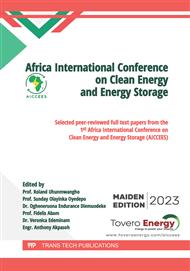[1]
Worldometer. (2023). Nigeria Population (LIVE). Retrieved from https://www.worldometers.info/world-population/nigeria-population/#:~:text=Nigeria%202023%20population%20is%20estimated,(and%20dependencies)%20by%20population
Google Scholar
[2]
Bureau of Public Enterprises (BPE). (2023). Nigerian Coal Corporation. Retrieved from https://www.bpe.gov.ng/nigerian-coal-corporation/
Google Scholar
[3]
SolarBuy. (2023). Solar Irradiation & Solar Potential in Nigeria. Retrieved from https://solarbuy.com/solar-101/solar-irradiation-solar-potential-in-nigeria/#:~:text=The%20findings%20reveal%20that%20solar,solar%20irradiation%20than%20the%20southern.
DOI: 10.1016/0379-6787(82)90033-3
Google Scholar
[4]
Olaide, Aderoju, Dias, António, & Echakraoui, Zhour. (2017). Assessment of Renewable Energy Sources & Municipal Solid Waste for Sustainable Power Generation in Nigeria. IOP Conference Series: Earth and Environmental Science, 95, 042043.
DOI: 10.1088/1755-1315/95/4/042043
Google Scholar
[5]
Akinyemi, L., & Zui, V. I. (2019). Summary of heat flow studies in Nigeria. Journal of the Belarusian State University. Geography and Geology, 2, 121–132
DOI: 10.33581/2521-6740-2019-2-121-132
Google Scholar
[6]
M. E. Emetere & G. E. Akpan (2023) Investigation of potential geothermal well locations in Nigeria using remote sensing and field measurement, International Journal of Sustainable Energy, 42:1, 627-647
DOI: 10.1080/14786451.2023.2217950
Google Scholar
[7]
Owebor, K., Diemuodeke, E. O., Briggs, T. A., & Imran, M. (2021). Power Situation and renewable energy potentials in Nigeria – A case for integrated multi-generation technology. Renewable energy, 177, 773-796. Advance online publication
DOI: 10.1016/j.renene.2021.06.017
Google Scholar
[8]
Adewumi, F. (2011, October 2). Nigeria's middle-class: How we live, and what we want from life. Retrieved April 27, 2018, from How We Made it in Africa: https://www.howwemadeitinafrica.com/nigerias-middle-class-how-we-live-and-what-we-want-from-life/12563/
DOI: 10.1007/978-3-662-64225-2_11
Google Scholar
[9]
Advisors, D. G. (2017). Improving Access to Electricity Through Decentralized Renewable Energy.
Google Scholar
[10]
Ashley-Edison. (2015, August 05). Retrieved April 04, 2018, from Voltage in Nigeria: https://www.ashleyedison.com/voltage-nigeria-868/
Google Scholar
[11]
Dalberg (2017). Improving access to electricity through decentralized renewable energy. Retrieved May 04,2017 from dalberg: https://dalberg.com/our-ideas/improving-access-electricity-through-decentralized-renewable-energy/
Google Scholar
[12]
Daly, H., & Walton, M. A. (2017, October). Energy Access Outlook 2017 From Poverty to Prosperity. Retrieved May 5, 2018, from OurEnergyPolicy.org: http://www.ourenergypolicy.org/energy-access-outlook-2017-from-poverty-to-prosperity/
DOI: 10.1787/9789264285569-en
Google Scholar
[13]
Energypedia. (n.d.). Retrieved April 07, 2018, from Nigeria Energy Situation: https://energypedia.info/wiki/Nigeria_Energy_Situation
Google Scholar
[14]
"Solve Electricity; Solve Nigeria's Economy Issues" (2017, May 22). P.M. News Nigeria. Retrieved April 8, 2018, from https://www.pmnewsnigeria.com/2017/05/22/solve-electricity-solve-nigerias-economy-issues/
DOI: 10.1108/oxan-db222322
Google Scholar
[15]
Ezeh, M. C., and E. R. Okoroafor (2023). "Balancing Energy Access in Sub-Saharan Africa: A Comparative Analysis of Energy Accessibility in Sub-Saharan Africa and Northern Africa." Paper presented at the SPE Nigeria Annual International Conference and Exhibition, Lagos, Nigeria, July 2023
DOI: 10.2118/217240-MS
Google Scholar
[16]
Ikhisemojie, S. (2016). Adverse health effects of poor electricity supply. Punch Nigeria. Retrieved April 5, 2018, from http://punchng.com/adverse-health-effects-poor-electricity-supply/
Google Scholar
[17]
"The Case for Clean Cooking", Clean and Improved Cooking in Sub-Saharan Africa: A Landscape Report, 2017, page 23.
Google Scholar
[18]
Gujba H., Mulugetta Y., and Azapagic A. "The Household Cooking Sector in Nigeria: Environmental and Economic Sustainability Assessment" Available online: www.mdpi.com/2079-9276/4/2/412/pdf (accessed on April 14 2018).
DOI: 10.3390/resources4020412
Google Scholar
[19]
Mills, E. (2016). Identifying and reducing the health and safety impacts of fuel-based lighting. Energy for Sustainable Development, 30, 39-50
DOI: 10.1016/j.esd.2015.11.002
Google Scholar
[20]
Scott, A., Worrall, L., Hörnberg, J., & To, L. S. (2017, Dec). How solar household systems contribute to resilience. Retrieved June 03, 2018, from https://www.odi.org/sites/odi.org.uk/files/resource-documents/11955.pdf
Google Scholar
[21]
UNDP. (2016, Dec). UNDP Support to the Implementation of Sustainable Development Goal 7. United Nations Development Programme. Retrieved June 01, 2018, from Sustainable Development Goals: http://www.undp.org/content/undp/en/home/sustainable-development-goals/goal-7-affordable-and-clean-energy.html
DOI: 10.18111/9789284419401
Google Scholar
[22]
Power Africa: Nigeria. (2023). USAID. Retrieved from https://www.usaid.gov/powerafrica/nigeria
Google Scholar
[23]
Kouzmanoff, J., Aigbokhan, G. E., & Kabir, H. (2017, April 26). Solar Plaza. Retrieved June 03, 2018, from Nigeria's Energy Landscape: https://sun-connect-news.org/fileadmin/DATEIEN/Dateien/New/Whitepaper_-_Nigeria_1.4.pdf
Google Scholar
[24]
OECD (2018). Making Blended Finance Work for the Sustainable Development Goals. Retrieved from https://assets.ctfassets.net/4cgqlwde6qy0/77K8guUYEwekieaIWmiSqm/8a2472bac649affc93e8558200c994ec/OECD__Making_Blended_Finance_Work__2018.pdf
DOI: 10.1787/9789264288768-4-en
Google Scholar
[25]
Power Africa: Nigeria. (2012-2017). USAID. Retrieved from https://2012-2017.usaid.gov/powerafrica/nigeria
Google Scholar
[26]
IRENA (2022) Off-Grid Sector Emerges to Plug Energy Access Gaps. International Renewable Energy Agency. Retrieved from https://www.irena.org/News/articles/2022/Dec/Off-Grid-Sector-Emerges-to-Plug-Energy-Access-Gaps
Google Scholar
[27]
Time Doctor (2022). Average Salary in Nigeria. Retrieved from https://www.timedoctor.com/blog/average-salary-in-nigeria/
Google Scholar
[28]
Nairametrics. (2015, August 23). Retrieved May 05, 2018, from See How Much Telecom Tower Operators Spend Daily To Power BTS: http://nairametrics.com/see-how-much-telecom-tower-operators-spend-daily-to-power-bts/
Google Scholar
[29]
Edomah, N., Ndulue, G., & Lemaire, X. (2021, September 7). A review of stakeholders and interventions in Nigeria's electricity sector. Heliyon, 7(9), e07956
DOI: 10.1016/j.heliyon.2021.e07956
Google Scholar
[30]
The Nigerian Energy Sector - An Overview with a Special Emphasis on Renewable Energy, Energy Efficiency and Rural Electrification 2nd Edition, June 2015 Published by: Deutsche Gesellschaft für Internationale Zusammenarbeit (GIZ) GmbH, Nigerian Energy Support Programme (NESP), and the Federal Ministry of Power Nigeria.
Google Scholar
[31]
Global Energy Network Institute. (n.d.). Nigerian National Electricity Grid. Retrieved from http://www.geni.org/globalenergy/library/national_energy_grid/nigeria/nigeriannationalelectricitygrid.shtml
Google Scholar
[32]
UNDP (2023) Breaking Boundaries: Unleashing Greening Investment Horizons in Africa and Developing Countries. UNDP Egypt. Retrieved from https://www.undp.org/egypt/speeches/breaking-boundaries-unleashing-greening-investment-horizons-africa-developing-countries
DOI: 10.1108/ijccsm.2013.41405caa.013
Google Scholar
[33]
Climate Bonds Initiative. (2017, December). Nigeria First Nation to Issue Climate Bonds Certified Sovereign Green. Retrieved from https://www.climatebonds.net/resources/press-releases/2017/12/nigeria-first-nation-issue-climate-bonds-certified-sovereign-green
Google Scholar
[34]
GET.transform (2021). Sierra Leone Case Study: A Cost-Reflective Mini-Grid Tariff Framework. Retrieved from https://www.get-transform.eu/sierra-leone-case-study-a-cost-reflective-mini-grid-tariff-framework/
Google Scholar
[35]
ESMAP RISE (Regulatory Indicators for Sustainable Energy) Platform. (2021). ESMAP. Retrieved from https://www.esmap.org/esmap-RISE
DOI: 10.1596/37888
Google Scholar
[36]
Rural Electrification Agency (REA). (n.d.). Retrieved from https://rea.gov.ng/
Google Scholar
[37]
National Agency for Climate Change and Environmental Research (NACCER). SON Approves National Standards for Biomass Cookstoves in Nigeria. (2018). Retrieved from https://naccnigeria.org/son-approves-national-standards-for-biomass-cookstoves-in-nigeria
Google Scholar
[38]
Ubogu, S. (2015, August). Country Report on Nigeria Energy Systems. Institute of Energy Economics, Japan (IEEJ). Retrieved from https://eneken.ieej.or.jp/data/6209.pdf
Google Scholar
[39]
Techno Oil (2018) Techno Oil Cook Safe Initiative. Retrieved from https://technooil.com/cooksafe-initiative/
Google Scholar


